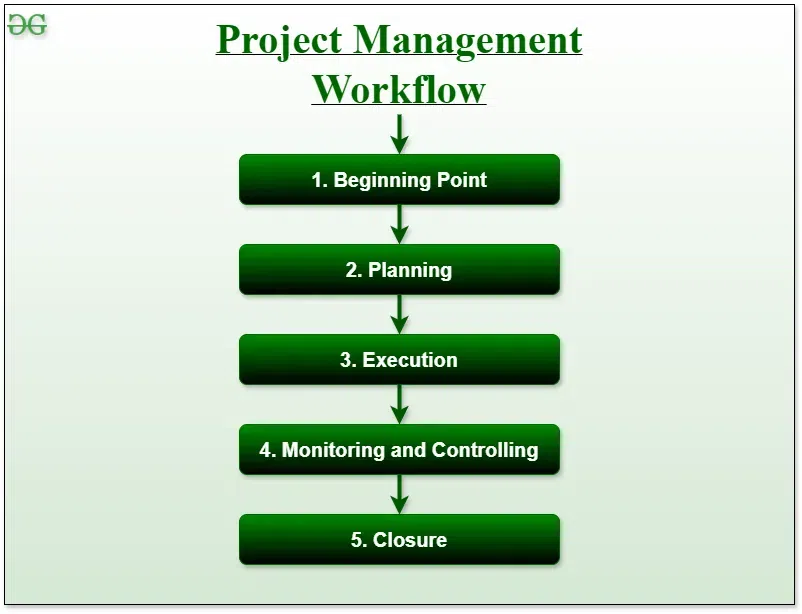What is Project Management Workflow and why is it important?
Last Updated :
27 Apr, 2024
A project’s execution workflow is an organized system that directs work on a project from start to finish. It includes processes for monitoring, planning, carrying out, and closing down to make sure projects are completed successfully. Understanding its importance is essential as it promotes structure, cooperation, and effectiveness in accomplishing project objectives within specified limitations.
What is Project Management Workflow?
A project management workflow is an organized set of procedures and actions intended to direct the implementation of a project from start to finish. It includes all phases of a project’s organization, planning, execution, control, and closing with the goal of reaching predetermined objectives within predetermined parameters including resources, time, and money. Defining project scope, assigning resources, making timelines, delegating tasks, tracking advancement, controlling risks, and guaranteeing high-quality deliverables are typical tasks included in this procedure. Workflows for project management that are effective help team members, stakeholders, and other interested parties collaborate, communicate, and coordinate in order to guarantee that projects are completed effectively and achieve the intended goals.
Why is Project Management Workflow Important?
- Clarity and Alignment: When roles, responsibilities, and objectives are well-defined, all project participants are aware of what is expected of them, which fosters alignment and a focus on shared objectives.
- Timeline Management: It assists in establishing reasonable deadlines and monitoring advancement, guaranteeing tasks are finished on schedule.
- Cost Control: It makes budget management possible, guards against excessive spending, and guarantees long-term financial stability.
- Continuous Improvement: It makes it easier to learn from previous experiences, which enables methods and approaches to be improved for upcoming initiatives.
- Resource Optimization: By allocating resources effectively in accordance with project needs, waste is decreased and productivity is increased.
Step-by-Step Project Management Workflow Guide

Project Management Workflow
1. Beginning Point
- Specify the objectives, aims, and scope of the project.
- Determine the parties involved and create routes of communication.
- Make a project charter that outlines the goals, limitations, and available resources.
2. Planning
- Assign tasks to the project and construct a Work Breakdown Structure (WBS).
- Determine the approximate amount of time, money, and manpower needed.
- Utilizing resources such as project management software or Gantt charts, create a project timetable.
- Determine and evaluate the risks, then create plans to reduce them.
- Establish acceptance requirements and quality standards.
3. Execution
- Assign work to team members according to their availability and skill sets.
- Call frequent team meetings to discuss problems and evaluate progress.
- Take quality control procedures to guarantee that deliverables fulfil requirements.
- Handle modifications and revisions to the project’s resources, timeline, and scope.
4. Monitoring and Controlling
- Monitor the status of the project in relation to the budget and timeline.
- Keep an eye on your key performance indicators (KPIs) to spot plan deviations.
- Put remedial measures in place to deal with problems and hazards as they emerge.
- Maintain constant contact with stakeholders in order to ask for input and offer updates.
5. Closure
- Make that the project’s deliverables and goals have been reached by reviewing them.
- Obtain the stakeholders’ formal approval.
- To identify areas for development and to highlight wins, hold a lessons learned session.
- Archive project records, and finish up any outstanding administrative work.
Best Practices for Using Project Management Workflows Efficiently
- Manage Risks Proactively: Proactively manage risks by identifying possible hazards early in the project and creating plans to reduce them. Throughout the course of the project, regularly reevaluate the risks, and be ready to put backup plans into place as needed.
- Promote Cooperation and Teamwork: Create a friendly, cooperative atmosphere where team members are empowered to exchange ideas, pose questions, and cooperate to achieve shared objectives.
- Resource Allocation: Assign work to team members in accordance with their qualifications and availability to make sure that resources are used efficiently and workloads are balanced.
- Effective Communication: To make sure that everyone is in agreement and informed on the status, modifications, and difficulties of the project, encourage open and honest communication between team members and stakeholders.
- Record Everything: Maintain thorough records of all project schedules, decisions, and modifications. This documentation guarantees that everyone gets entry to to the records they require and acts as a useful reference.
- Evaluate and Revise Plans Frequently: Keep an eye at the project’s development in contrast to the plan, and be prepared to make modifications as needed. Schedules, budgets, and resource allocations must all be up to date to account for adjustments and maintain progress of the project.
Related Articles:
Conclusion: Project Management Workflow
The foundation of any effective project execution is its project management workflow, which offers direction, clarity, and control at every stage of the project’s lifespan. Its capacity to maximize resources, control risks, promote communication, and guarantee quality results makes it crucial, eventually boosting project success and stakeholder satisfaction.
FAQs on What is Project Management Workflow and why is it important?
What is the general structure of a project management workflow?
Creating a project plan, allocating tasks, monitoring progress, addressing problems, and delivering the finished good or service are all common steps in a workflow.
What advantages come with putting in place a project management workflow?
Benefits include increased efficiency, better communication, better resource allocation, better organization, and a higher chance of project success.
3. What distinguishes project management workflow from traditional project management?
While project management workflow focuses explicitly on the order and flow of tasks inside a project, project management refers to the entire discipline of planning, organizing, and regulating resources to achieve specified project goals.
Share your thoughts in the comments
Please Login to comment...